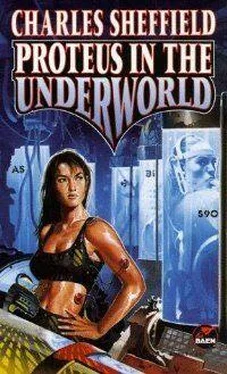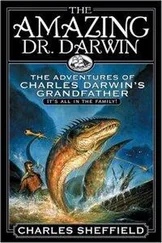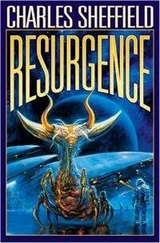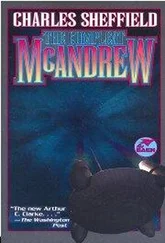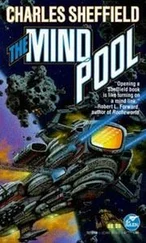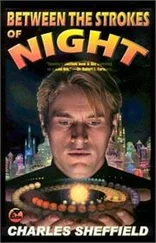Charles Sheffield - Proteus in the Underworld
Здесь есть возможность читать онлайн «Charles Sheffield - Proteus in the Underworld» весь текст электронной книги совершенно бесплатно (целиком полную версию без сокращений). В некоторых случаях можно слушать аудио, скачать через торрент в формате fb2 и присутствует краткое содержание. Год выпуска: 1995, ISBN: 1995, Издательство: Baen Books, Жанр: Фантастика и фэнтези, на английском языке. Описание произведения, (предисловие) а так же отзывы посетителей доступны на портале библиотеки ЛибКат.
- Название:Proteus in the Underworld
- Автор:
- Издательство:Baen Books
- Жанр:
- Год:1995
- ISBN:0-671-87659-7
- Рейтинг книги:3 / 5. Голосов: 1
-
Избранное:Добавить в избранное
- Отзывы:
-
Ваша оценка:
- 60
- 1
- 2
- 3
- 4
- 5
Proteus in the Underworld: краткое содержание, описание и аннотация
Предлагаем к чтению аннотацию, описание, краткое содержание или предисловие (зависит от того, что написал сам автор книги «Proteus in the Underworld»). Если вы не нашли необходимую информацию о книге — напишите в комментариях, мы постараемся отыскать её.
Proteus in the Underworld — читать онлайн бесплатно полную книгу (весь текст) целиком
Ниже представлен текст книги, разбитый по страницам. Система сохранения места последней прочитанной страницы, позволяет с удобством читать онлайн бесплатно книгу «Proteus in the Underworld», без необходимости каждый раз заново искать на чём Вы остановились. Поставьте закладку, и сможете в любой момент перейти на страницу, на которой закончили чтение.
Интервал:
Закладка:
Bey went back to his programming of the form-change machine. So close, so very close. It was far more than the ninety-nine percent of common DNA. Four hundred years ago, long before DNA had been dreamed of, almost a hundred years before Darwin, the great Swedish biologist Carl Linnaeus had made up his mind. He didn’t dare to say that humans and chimps belonged in the same genus, because that would have created a religious fire-storm. Humans were supposed to be special, God-created, unique. But Linnaeus had confided his own true feelings in a letter to a friend:
“I demand of you and of the whole world that you show me a generic character to distinguish between Man and Ape. I myself most assuredly know of none, and I wish somebody would indicate one to me. But if I had called man an ape or vice versa I would have fallen under the ban of all the ecclesiastics.”
You couldn’t work with chimps for more than a week or two without sharing Linnaeus’s opinion. The line was hard to draw. But somehow, the form-change equipment could do it. No chimp had ever managed a form-change. Bey began to set up the final parameters for his own program. Maybe it was the purposive element that the chimp could not manage. The thoughts of a chimp—there was no doubt that Jumping Jack Flash had thoughts—were probably foggy and imprecise, a more extreme version of Bey’s own muddled thinking when the electronic pain-inhibitors were doing their job. Successful form-change implied a basic capability for precision of thought.
That insight pulled Bey himself to a higher state of alertness. If his brain was operating at half-power, he had to be extra careful in setting up form-change sequences. He went over everything again, slowly and carefully. Only when he had made every check that he could think of did he turn again to the animals.
“Six days, and I’ll be out of the tank again. All right? You have plenty of food and plenty of water. Flash, save a few of the papayas for me. I noticed there were lots of almost-ripe ones when I was coming up from the beach, and I know what a glutton you are.”
He climbed laboriously into the tank. His exoskeleton had been designed for slow, linear movement, and climbing was not on the list of recommended activities. Getting the skeleton off was even harder work. Bey struggled free and dropped it in a heap outside the tank rather than neatly disassembling it.
The pain-inhibitors at the nape of his neck came off last. Bey almost screamed when their action ceased. With the help of the exoskeleton he had moved as no man with multiple broken bones should ever move, and now he was paying for it. He made the interior connections of the tank one-handed, with trembling fingers. When he was finally done he swung the heavy door to and sealed it. His last sight of the animals showed that they were still outside and silently watching.
He leaned back, waiting for the program to begin. He was proposing to do in six days what normal protocols would do in seventeen. His remedial program was safe enough, not pushing the limits in any area. It would even suppress all traces of conventional pain while it was operating.
Unfortunately, there was such a thing as unconventional pain—pain deep down at the individual cell level; pain as the body’s operating parameters took an excursion far from normal to regions of internal temperature and chemical imbalance that meant death without the help of a form-change tank’s careful monitoring and adjustment of hormonal and nutrient levels; pain beyond belief or description.
As that pain began, Bey asked himself why he was doing this—why wasn’t he taking the standard seventeen day route? What was the rush?
That was when he realized, for the first time, that something would be waiting for him when he emerged. Something of thought, some analysis that would need every scrap of his brain-power undimmed by pain inhibitors. For such thought he needed to be in top physical condition. But thought about what?
It was intuition again; intuition in its most maddening form, offering strong opinions and even orders without allowing the logical mind any justification or argument.
Bey lay back in the tank and allowed deep pain to wash him away on its tide. When that tide came back in, maybe he would finally learn the reason for his suffering.
CHAPTER 19
Sondra’s first impulse was to call Bey and ask him what calls he had made in the past couple of months about the problem of the feral forms. Two minutes’ thought convinced her that was a terrible idea.
First, the ship that she was on had no provision for a high-speed link to Earth or Mars. With a standard radio signal she would sit in Saturn orbit for many hours before any reply could possibly come to her. More than that, Bey didn’t know anything about the flight of Trudy Melford’s ship to Samarkand, a journey that Robert Capman had pronounced to be “curious and anomalous.” That must have something to do with the problem.
And finally there was the simple matter of pride. Capman had told her that she had enough information to solve this for herself, without assistance.
Not enough brains—he had carefully avoided any such statement—but enough information.
Which meant that if she didn’t solve it by her own efforts, everything that Bey had said about her would be true.
Sondra ordered the ship to quit Saturn orbit, but not to head for Earth and the inner system. She had decided to head outward again, for the Kuiper Belt. She set her destination as the colony worldlet of Samarkand, but after a few minutes she changed that instruction. First she must head for Rini Base. Capman had told her that she needed to query the inner system’s general information bank and learn what calls Bey had made or received since she had first met him. The only efficient way to do that was through a rapid link, and Aybee on Rini Base controlled the only one she knew about.
All the way out to the Kuiper Belt she pummeled her brains. There was a logical explanation to her problem. Knowing that, and knowing that someone else knew what it was while she did not, was worse than if there were no explanation at all—even if the other someone was a Logian form, She thought and thought; and got nowhere.
By the time the ship reached Rini Base, Sondra had her tail thoroughly between her legs. Aybee did not seem to notice. He was tinkering with a little chain of silver elements, and he did not even look up when she drifted in through the jumble of cables and cabinets that defined what he called his office. But he knew she was there, because after a while he grunted and said, “Wouldn’t see you after all?”
“Saw me. Listened to me. Left me.”
“Figures. Most people don’t get far with Capman. What you want with me? I’m busy.”
“What is that thing you’re working on?”
“You wouldn’t understand if I told you.” He glared up at her for a moment. “What you want?”
“If you’re as smart as you think you are, how come Capman hasn’t recruited you? He asked Bey Wolf to go to Saturn long ago, and become a Logian.” As a way to annoy Aybee, it was a total failure.
“Sure he did.” Aybee looked smug and poked at the silver chain with a little metal awl. “Know why? ’Cause the Wolfman’s gettin’ way up there in age, that’s why. The Logians don’t take anybody ’til he’s well into geeze stage.”
“You mean until he’s done something in the world— instead of only talking about it, like you.”
Aybee just grinned and kept his attention on what he was doing. “We’re in a mood today, aren’t we? Anyway, the Logians don’t say they wait until you’re past it, because if they did no one would want to go. What they say is good high-flown waffle-you know, ’until someone fully knows what it is to be human, and has experienced a full human life with all its joys and sorrows, it is not right for that person to change to Logian form.’ That sort of rubbish.”
Читать дальшеИнтервал:
Закладка:
Похожие книги на «Proteus in the Underworld»
Представляем Вашему вниманию похожие книги на «Proteus in the Underworld» списком для выбора. Мы отобрали схожую по названию и смыслу литературу в надежде предоставить читателям больше вариантов отыскать новые, интересные, ещё непрочитанные произведения.
Обсуждение, отзывы о книге «Proteus in the Underworld» и просто собственные мнения читателей. Оставьте ваши комментарии, напишите, что Вы думаете о произведении, его смысле или главных героях. Укажите что конкретно понравилось, а что нет, и почему Вы так считаете.
